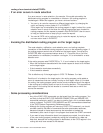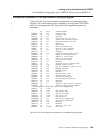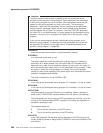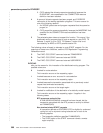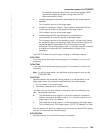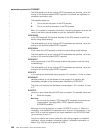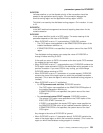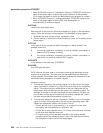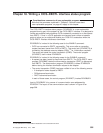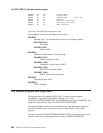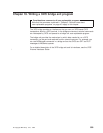v When DYRFUNC is set to ‘5’ (transaction initiation), DYRSYSID contains the
name of the target region on which the routed request is to be executed.
(This is also the region on which the distributed routing program is invoked.)
v When DYRFUNC is set to ‘6’ (routing completed), DYRSYSID contains the
name of the target region to which CICS tried (successfully or
unsuccessfully) to route the request.
DYRTRAN
contains the transaction name.
Note that this is
the name by which the transaction is known in the requesting
region
. Unlike the dynamic routing program, the distributed routing program:
1. Is passed the local, not the remote, transaction name
2. Cannot specify an alternative remote transaction name, for forwarding to the
target region.
DYRTYPE
is the type of routing request for which the program is being invoked. The
possible values are:
5 For routing, notification, completion of routing, initiation, termination, or
abend of a BTS process or activity.
6 For routing, notification, completion of routing, initiation, termination, or
abend of a non-terminal-related START request.
DYRUAPTR
is the address of the user area (DYRUSER).
DYRUSER
is a 1024-byte user area.
CICS initializes this user area to nulls before invoking the distributed routing
program for a given task. This user area can be modified by the distributed
routing program; the modified area is passed to subsequent invocations of the
distributed routing program for the same request.
However, note that:
1. The user area passed to the routing program on its first call on the target
region (“transaction initiation”) is a
copy
of the user area on the requesting
region. This means that any modifications to the user area made on the
target region have no effect on the user area in the requesting region. For
example, a change to the user area made on the transaction initiation call
has no effect on the user area passed to the routing complete call, even if
the latter occurs after the transaction initiation call.
2. The user area passed to the first (“transaction initiation”) call on the target
region is a copy of that returned by
the call on the requesting region that
caused the transaction initiation call to occur
. That is:
v If there was no error in route selection, it is a copy of the user area
returned by the route selection or notification call.
v If there was a route selection error, it is a copy of the user area returned
by the final route selection error call.
v It is
never
a copy of the user area returned by the routing attempt
complete call on the requesting region, even if the latter occurs before
the transaction initiation call on the target region.
parameters passed to DFHDSRP
592
CICS TS for OS/390: CICS Customization Guide
|
|
|
|
|
|
|
|
|
|
|
|
|
|
|
|
||
|
||
|
|
|
|
|
|
|
|
|
|
|
|
|
|
|
|
|
|
|
|
|
|
|
|
|
|
|



